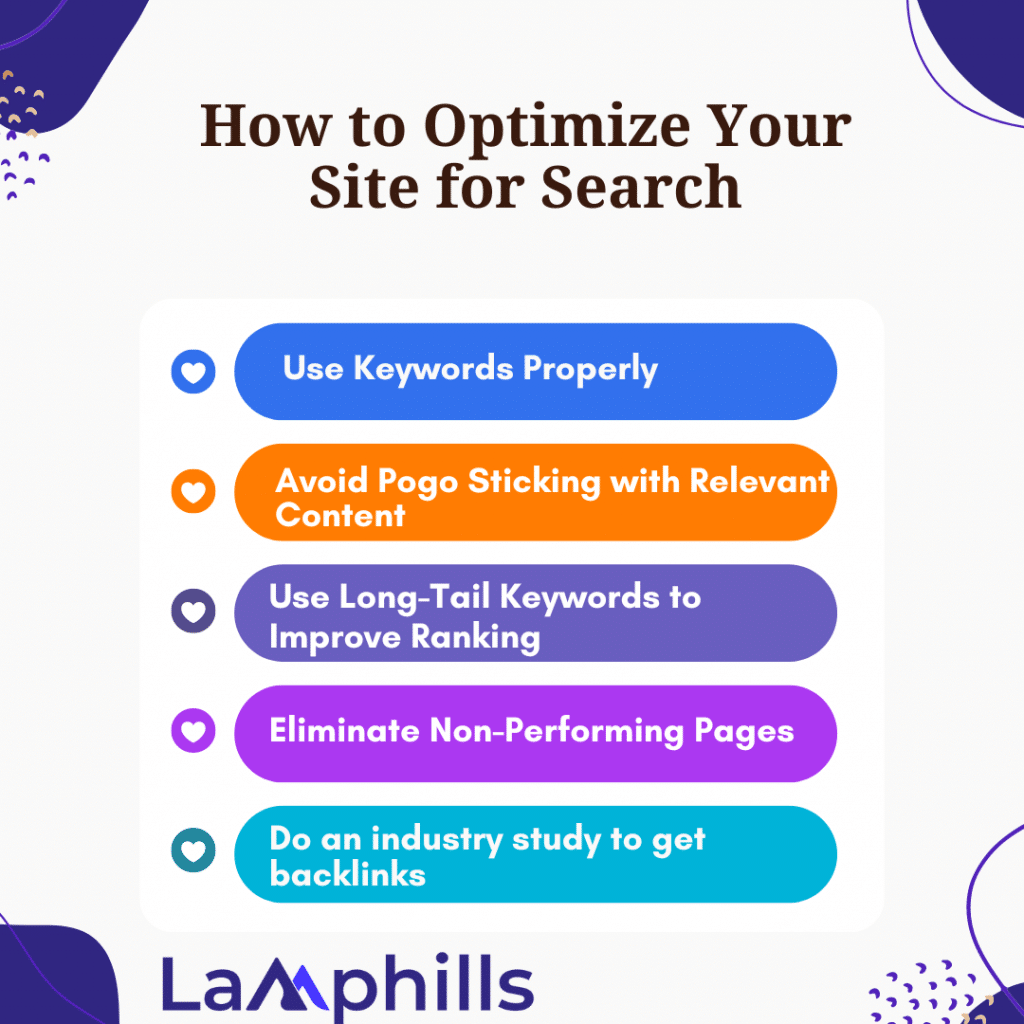When I first started learning about SEO, I encountered a lot of so-called “facts” regarding what works and what doesn’t. Some seemed rational, while others simply didn’t make sense. After testing numerous of these tactics, I discovered that some were really damaging my website’s rankings. In this article, I’ll address five prevalent assumptions about SEO marketing in 2024 that could be harming your rankings, supported by statistics and insights you won’t find anywhere else. Let’s get started and clear up some common myths to assist you enhance your SEO game.
What is SEO Marketing?
In the digital age, a corporation must have an online presence. An SEO marketing plan makes it easy for search engines such as Google and Bing to “crawl” your material and identify where it should appear in SERPs.
SEO often falls into three categories:
- On-page SEO refers to the content and structure of a webpage. Search engines look for content that is related to the keyword, meets searcher intent, is well-structured and easy to explore, and provides authoritative information within an industry.
- Off-page SEO refers to the backlinks that a website acquires. Backlinks happen when other websites connect to pages on your site. SEO benefits from authoritative and relevant content. Backlinks can help your website gain authority and exposure over time.
- Technical SEO refers to the backend features of your website, such as the title tags and meta descriptions that appear in the source code of a webpage, the site’s structure and navigation, how pages within a site are linked together, and the site’s loading time.
The goal is to optimize items in all three categories and ensure that they work together to increase organic visibility for your website and its content.
Type of SEO Marketing
SEO actions are divided into three broad areas. Let’s look at them.
- On-Page SEO
- Off-Page SEO
- Technical SEO
#1. On-Page SEO
On-page SEO, the broadest category of SEO marketing operations, is optimizing your website’s content (including text, photos, and videos) so that users and search engines can understand and navigate the material you provide.
Search engines check for on-page characteristics that influence the quality of your content and, as a result, where your site appears in search results pages. On-page SEO elements include topic relevance, metadata, and the slug of your page URL.
1. Topic relevance
Web pages with high search engine rankings provide material that closely fits users’ search intent. That implies you should consider what searchers are looking for when they type queries and supply the information or services they require.
Best practices for creating SEO content include providing unique information, updating facts frequently, and focusing on themes relevant to your website’s area of expertise.
2. Metadata
Metadata does not show on your web pages, thus it is not visible to typical visitors. Instead, meta information is embedded in the HTML code of your pages, classifying and labeling content in an easy-to-digest style for search engine bots crawling your website.
Maintaining comprehensive and up-to-date meta information will increase your content’s chances of ranking. Metadata contains details such as:
- Title tags identify a web page.
- Meta descriptions summarize the contents of a web page.
- Heading and subheading tags help arrange material and indicate topic depth.
- Robot tags inform search engines whether to index pages and follow links.
3. URL slug
A webpage’s slug identifies it in your website directory. The slug follows the backslash (“/”) in your website’s URL. For example, the slug for this page is “seo-marketing.”
Slugs are scanned by search engines and visitors to determine what information is on a page. Choose a slug that closely reflects the web page’s content and keywords.
#2. Off-Page SEO
SEO marketing does not have to be limited to your website; you can also improve your search engine rankings by making efforts on other websites.
Off-page SEO focuses on creating backlinks that boost your domain authority. That is links on other websites that direct visitors to your site.
1. Backlinks
Google’s PageRank algorithm includes a survey of linkages between web pages. This ranking mechanism was one of the first ways Google determined search engine results and is still an important component of SEO marketing strategy.
Earning links from reputable websites will improve your topic authority and ranking abilities. Essentially, the more high-quality backlinks you have, the more trustworthy search engines will consider your website to be.
This is predicated on the premise that material from high-quality websites would be automatically linked and spread.
2. Domain authority
As you generate content, build links, and increase traffic, your website’s domain authority will rise.
Domain authority measures a website’s reliability in the eyes of search engines. Older websites with high domain authority are more likely to appear on search engine results pages for keywords relating to their field of expertise.
#3. Technical SEO
Technical SEO is the process of making changes to your website’s code to boost search performance. Technical SEO ensures that your website is quick, optimized for search engine crawlers, and mobile-friendly.
SEO vs SEM Marketing
To better grasp the distinctions between SEO and SEM marketing, let us clarify the terminology.
As previously said, SEO stands for search engine optimization. It is the process of getting your content to rank in search engines. SEM, or search engine marketing, is the technique of increasing traffic to your website through paid searches. Organic means that you appeared in the SERP as an unpaid top result, which is SEO marketing. However, you may also pay the search engine to display your information as a paid ad or result. This is SEM marketing.
Both of these phrases are frequently confused and used interchangeably. However, the essential difference is that one is organic and the other is compensated. Organic does not imply that you need not have a marketing budget. You’ll still have to pay for the SEO research that will help you create your content. You won’t be paying the search engine to feature the information. Instead, you pay your content staff to create SERP-winning material.
Why is SEO Marketing Important?
The simple truth is that SEO marketing is vital since it promotes your content. Being visible helps customers learn and trust your brand. This boosts your capacity to sell your products and services because you have established trust by achieving a top ranking. Since the purpose of SEO marketing is to attract people to click on your website, having good SEO campaigns increases your company’s visibility.
Here are some major benefits of an SEO marketing campaign:
- It is a low-cost technique to get eyes onto your business’s website.
- When done correctly, it provides an excellent return on investment.
- SEO research provides practical data that you may utilize to create or update content.
- Winning in the SERPs allows you to establish credibility and trust with your audience.
- It draws relevant users because individuals find you by inputting a certain search keyword or inquiry.
Remember that the purpose of SEO marketing is to rank high on search engine results pages. You want to be the first listing because that’s what searchers will most likely click on. You want to be on the top page of the SERPs since visitors may click on multiple sites, but they rarely move to the second or third page to check on other results. They frequently find what they are seeking in the first SERP. This is why your SEO should be effective.
How To Optimize Your Site For Search
Knowing that SEO is essential for your online marketing efforts is one thing. Another option is to create an effective plan. Here are some basic strategic strategies to improve your website for search.

#1. Use Keywords Properly
You already know that you should have keywords and use them on your website. However, it is critical to understand where to place them to optimize the benefit of search engine optimization.
The keyword should occur in the title tag at least once. This is what readers see when your article appears in the search engine results. You also want the keyword to appear in your URL. This informs the search engine what your page is about. Include the keyword within the first 100 words of the content. Some experts and tools, such as Yoast, prefer that you include the keyword in the first sentence. Either way, get to the point and tell readers what your piece is about—the keyword.
Those are three important areas to include the keyword. You’ll also want to employ it throughout the text but avoid excess, as this might be deemed keyword stuffing. The optimum practice would be to use it five to seven times every thousand words.
#2. Avoid Pogo Sticking with Relevant Content
Pogosticking occurs when consumers visit your site but immediately leave. Search engines track how long users spend on a website and offer more respect to those who keep readers on longer. It’s not enough to simply get people to visit your website; you also want them to stay there.
If someone pogo-sticks on your site, it signifies they didn’t find the solution they were looking for and went back to the search results to locate a better source. When this occurs regularly on your site, search engines will push you down in the SERP ranks.
So, how can you avoid pogo-sticking? You create material that addresses the needs of the keywords. Don’t beat around the bush; instead, get to the point so that readers know you have relevant content and want to read more to get the solutions. For example, bullet lists and headers can be used to break up large tracts of text, making the content easier to read and more visually appealing.
#3. Use Long-Tail Keywords to Improve Ranking
Long-tail keywords are those that have a tail word or phrase after the keyword. These keywords go a step further in search, indicating exactly what consumers read. To obtain a feel of long-tail keywords, enter the keyword into the search query and observe what other alternative keywords appear in a drop-down list.
Include long-tail keywords in your content to improve search results. By developing content that covers long-tail keywords, you can ensure that you are capturing the specifics that the reader is looking for.
#4. Eliminate Non-Performing Pages
Non-performing pages are commonly referred to as zombie pages, as they exist but receive no traffic. They do not improve your site’s rating because they lack useful material, so it is best to remove them. This, in turn, will re-index your site on the search engine, allowing it to determine that all of your information is relevant and useful.
Use a tool like Semrush to see which pages are generating traffic and which are not. Remove any elements from your site that aren’t serving you well. Search engines appreciate a substantial page of relevant content over a collection of little fragments of content that are difficult to organize and find beneficial.
#5. Do an industry study to get backlinks
Remember that a backlink is a link from an outside website that recommends your site’s content. It indicates that the website either used you as a source or believes your website is a useful resource for more reading. However, backlinks can be difficult to obtain.
This is where conducting an industry analysis can be really beneficial. When you undertake a study, you become an industry expert. The figures you obtain from the study can be used by others in the industry, who will cite you as the source of the data. Though it may take some effort and money, becoming an industry data leader is ultimately worthwhile.
5 SEO Myths That Are Killing Your Ranking
Myth #1: Keywords Must Be Your Primary Focus
One of the most common illusions in SEO is that cramming your content with keywords can boost your ranks. While keywords are crucial, overemphasizing them can harm your website’s performance.
Google’s algorithm has evolved to the point where it can understand context and semantics in addition to keywords. According to an Ahrefs study, 91% of content receives no Google traffic, which is largely due to a focus on keywords rather than giving value.
When I originally started optimizing for SEO, I concentrated primarily on keyword density. However, my traffic did not increase until I began writing material that directly addressed my audience’s needs and questions.
Instead of keyword stuffing, create high-quality, meaningful content that addresses user intent.
Myth #2: Backlinks are all that matters
Many people feel that the sheer volume of backlinks will improve your rankings. However, not all backlinks are equal, and relying simply on numbers can be negative.
Backlinks should be of high quality rather than quantity. According to Moz, a few high-quality connections from authoritative sites are worth more than dozens of low-quality links.
Early in my SEO experience, I sought as many backlinks as possible, regardless of source. My results improved significantly after I began targeting respected, relevant sites.
To significantly boost your search engine rankings, prioritize collecting backlinks from high-authority, relevant sites.
Read Also: What Is Link Farming and Why Is It Considered a Black Hat SEO Tactic?
Myth #3: SEO is a one-time task
Many individuals believe that once their site is optimized, they can forget about SEO. However, SEO is a continual process that necessitates consistent effort.
Search engine algorithms are continuously evolving, so what works today may not work tomorrow. According to Search Engine Journal, Google adjusts its algorithm hundreds of times every year, making it critical to stay current on SEO best practices.
I once optimized my site and had amazing results, but my traffic gradually decreased. It wasn’t until I reevaluated and modified my SEO strategy that I was able to restore and enhance my rankings.
To maintain and increase your results, update your SEO methods regularly and stay up to date on algorithm updates.
Myth #4: Meta descriptions have a direct impact on rankings
A popular fallacy is that meta-descriptions are used to rank websites. While they have no direct impact on your rankings, they play an important function in garnering clicks from search results.
Although meta descriptions have no direct impact on rankings, they do have an impact on click-through rates (CTR), which might affect your SEO performance. According to Backlinko, interesting meta descriptions can considerably increase your CTR, hence indirectly improving your ranks.
By focusing on creating engaging meta descriptions, I saw a significant rise in CTR, which led to improved overall performance in search results.
Write interesting meta descriptions to increase CTR and indirectly impact SEO performance.
Myth #5: SEO guarantees quick results
SEO is frequently advertised as a quick remedy for increasing your internet visibility. However, successful SEO requires time and perseverance.
SEO is a long-term approach, and results may take months to appear. According to an Ahrefs analysis, just 5.7% of newly published pages will reach Google’s top ten after a year.
I was first upset with the slow development of my SEO efforts, but by remaining constant and patient, I eventually witnessed big and long-term increases in my rankings.
Be patient and consistent in your SEO efforts, and remember that it is a long-term plan rather than an immediate solution.
The Use of Templates in SEO Marketing
Using an SEO Strategy Template will help you streamline your efforts and ensure that you cover all parts of SEO, including keyword research, link development, and content optimization. This template might assist you in taking a consistent and effective approach to enhancing your search engine results.
Ready to take your SEO efforts to the next level? Download our comprehensive SEO Strategy Template now to streamline your process, ensure consistency, and start improving your search engine rankings today.
Conclusion
Debunking these common SEO myths may help you avoid methods that may harm your rankings. Concentrate on providing useful content, gaining high-quality backlinks, and keeping a consistent SEO strategy. Have you ever fallen for any of these SEO myths? What tactics have you discovered to be the most effective in enhancing your rankings? Let’s continue the conversation in the comments section.
Related Articles
- SEO Reputation Management: How I Protect & Enhance My Online Presence
- The Best SEO Automation Software Tools for 2024
- SEO Monitoring for Beginners: Why It’s Crucial (And How to Get Started)
- What Is Link Farming and Why Is It Considered a Black Hat SEO Tactic?






